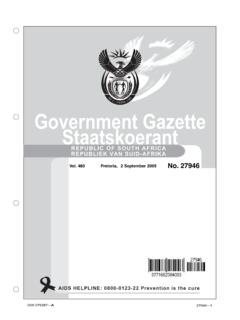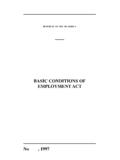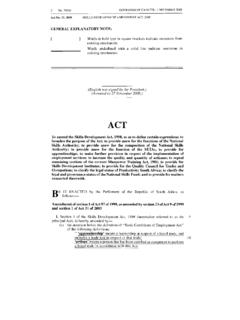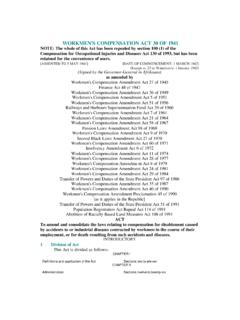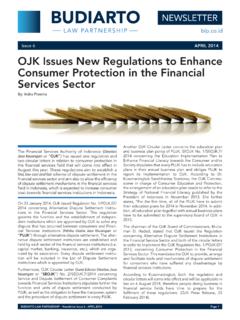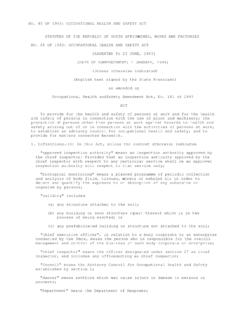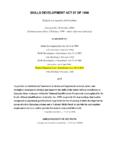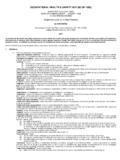Transcription of Schedule Definitions - Department of Labour
1 GENERAL MACHINERY REGULATIONS. [These regulations were first published in GN R1521 of 5 August 1988.]. The minister of manpower has, under section 35 of the Machinery and Occupational Safety Act, 1983 (Act 6 of 1983), made the regulations in the Schedule . Schedule _____. Definitions 1. In these Regulations any word or expression to which a meaning has been assigned in the Act, shall have the meaning so assigned and, unless the context otherwise indicates- "building work" means building work as defined in the General Administrative Regulations, published under Government Notice of 5 October 1984.
2 "certificated engineer" means any person to whom a certificate of competency referred to in regulation E1 (1) of the Regulations, published under Government Notice of 28 June 1963, has been granted and includes any person who is the holder of a certificate of competency in mechanical or electrotechnical engineering issued before 1 January 1966 under the Mines and Works Act, 1956 (Act 27 of 1956);. "competent person" in relation to machinery, means any person who- (a) has served an apprenticeship in an engineering trade which included the operation and maintenance of machinery, or has had at least five years' practical experience in the operation and maintenance of machinery, and who during or subsequent to such apprenticeship or period of practical experience, as the case may be, has had not less than one year's experience in the operation and maintenance appropriate to the class of machinery he is required to supervise.
3 (b) has obtained an engineering diploma in either the mechanical or electrotechnical (heavy current) fields with an academic qualification of at least T3 or N5, or of an equivalent level, and who subsequent to achieving such qualification has had not less than two years' practical experience in the operation and maintenance appropriate to the class of machinery he is required to supervise;. (c) is a graduate engineer and has had not less than two years' post-graduate practical experience in the operation and maintenance appropriate to the class of machinery he is required to supervise and who has passed the examination on the Act and the regulations made thereunder, held by the Commission of Examiners in terms of regulations E5 (2) of the regulations published under Government Notice of 28.
4 June 1963; or (d) is a certificated engineer;. "divisional inspector" means the divisional inspector referred to in regulation 1 of the General Administrative Regulations, published under Government Notice of 5. October 1984;. "electrical installation" means any electrical installation as defined in regulation 1 of the Electrical Installation Regulations, published under Government Notice of 11 October 1985;. "elevator" means any lift, hoist or other appliance used for the conveyance of persons and goods by means of a car, cage, cradle or other receptacle in a hatchway on fixed guides, but does not include a builder's hoist or a hoist worked by hand power.
5 "escalator" means any power-driven inclined continuous stairway with moving steps and hand rails which is intended for the conveyance of persons from one level to another;. "goods elevator" means any elevator used solely for the conveyance of goods and such attendants and operators as are necessary and authorised to travel therein, but does not include a hoist worked by hand power;. "graduate engineer" means any person who has obtained a degree in mechanical or electrotechnical engineering at a South African university, or a degree recognised by the Department of National Education as equivalent to any such degree.
6 "live" or "alive" means electrically charged;. "shiftsman" means any person employed to supervise the use of machinery and who has the necessary knowledge and experience to ensure the safe use of such machinery;. "the Act" means the Machinery and Occupational Safety Act, 1983 (Act 6 of 1983). Supervision of Machinery 2. (1) In order to ensure that the provisions of the Act and these Regulations in relation to machinery are complied with, an employer or user of machinery shall, subject to this regulation, in writing designate a person in a full-time capacity in respect of every premises on or in which machinery is being used.
7 (2) The chief inspector may, subject to such conditions as he may impose, permit an employer or user of machinery to designate more than one person in terms of subregulation (1). (3) Subject to the provisions of this regulation, an employee designated in terms of subregulation (1) shall be a competent person. (4) (a) If- (i) the sum of the power generated by machinery on or in the premises in question and the power derived from other sources, including the generation of steam for process purposes, exceeds 1200 kW, but is less than 3000 kW, the person designated in terms of subregulation (1) shall be a person as referred to in paragraph (b), (c) or (d) of the definition of "competent person".
8 (ii) any such sum is 3000 kW or more, the person so designated shall be a person as referred to in paragraph (c) or (d) of the said definition . (b) For the purpose of paragraph (a), the power derived from the generation of steam by any particular boiler shall be calculated in kW by dividing the manufacturer's rated evaporative capacity (in kg of water per hour at 100 C) by 21 or, in the absence of any such rated evaporative capacity, by multiplying the heating surface of that boiler (in m2) by 0,8.
9 (5) If, in the case where machinery on or in the premises in question is used solely for the distribution of electricity- (a) the maximum demand over any continuous period of 30 minutes is 3000 kVA or less, the person designated in terms of sub-regulation (1) shall be a person as referred to in paragraph (a) of the definition of "competent person" and registered as an installation electrician in terms of regulation 11 (1) of the Electrical Installation Regulations, promulgated under Government Notice of 11 October 1985.
10 (b) any such demand exceeds 3000 kVA, but is less than 10000 kVA the employee so designated shall be a person as referred to in paragraph (b), (c) or (d) of the said definition ;. (c) any such demand is 10000 kVA or more, the employee so designated shall be a person as referred to in paragraph (c) or (d) of the said definition . (6) Notwithstanding the provisions of subregulations (3), (4) and (5), the chief inspector may, subject to such conditions as he may impose, permit an employer or user of machinery to designate a person who holds any qualification other than that of a competent person in terms of subregulation (1).

